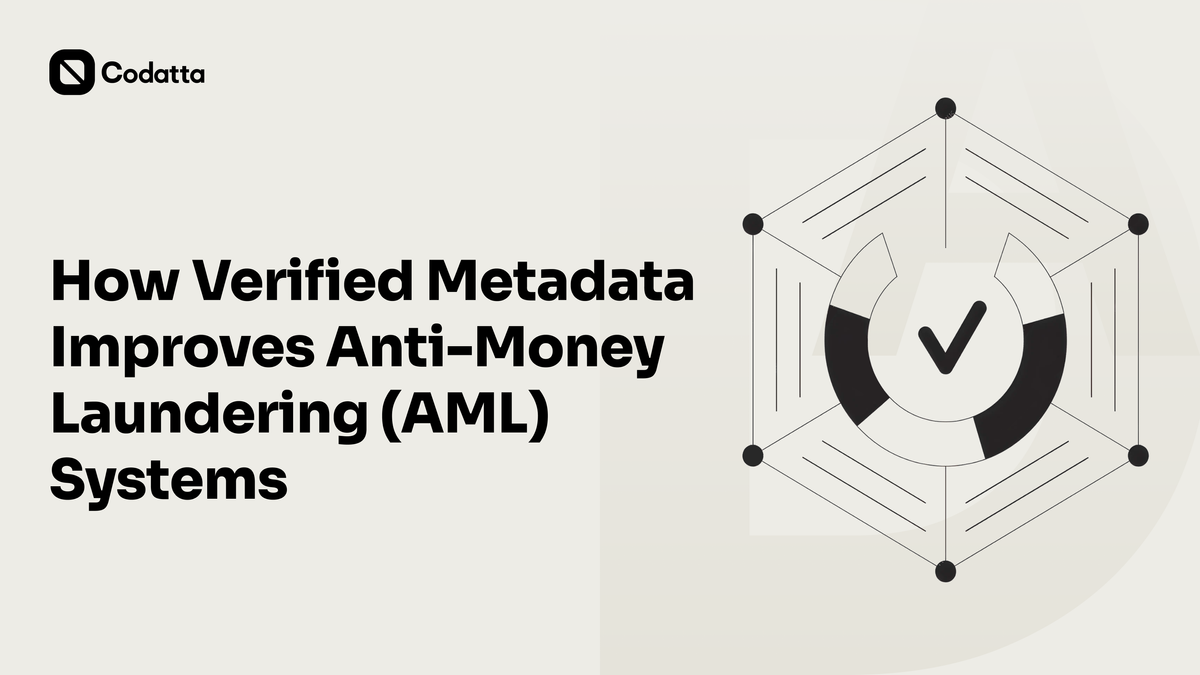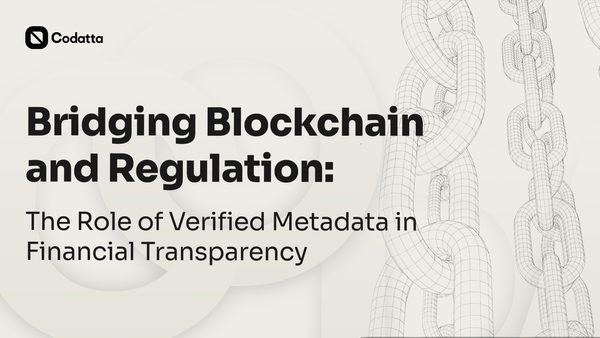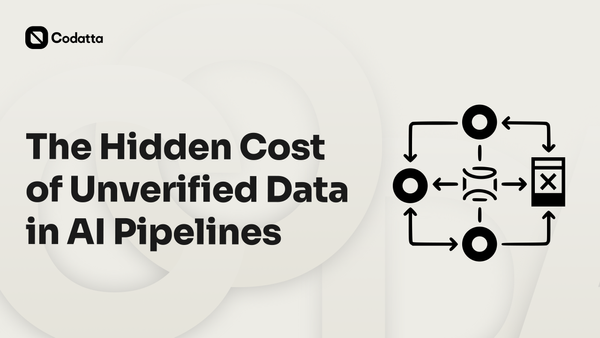How Verified Metadata Improves Anti-Money Laundering (AML) Systems

Anti-money laundering (AML) systems are only as effective as the data they rely on. When information about wallet activity or transaction history is fragmented or unverifiable, even the most advanced analytics fall short. Traditional AML tools still depend on centralized databases and incomplete reporting, leaving major gaps in visibility across blockchain networks.
Verified metadata offers a way forward, adding structured, validated context to every data point and improving how risks are detected and assessed.
Read on to see how Codatta’s decentralized data layer strengthens this foundation, making blockchain intelligence more transparent and reliable.
Why Traditional AML Systems Struggle
AML programs rise or fall on the quality, provenance, and coverage of their data. In practice, fragmentation across exchanges, analytics vendors, and regulators means the same customer or wallet can appear under different records, with gaps in KYC/identity verification, transaction monitoring, and risk assessment. FATF has repeatedly flagged uneven implementation of virtual-asset AML controls such as Recommendation 15 and the Travel Rule, which leaves financial institutions and VASPs with inconsistent data sharing and limited on-chain traceability for suspicious activities.
Coverage is another issue. Even sophisticated AML systems miss activity that routes through a small set of fiat off-ramps or high-risk services, producing false positives in some segments and blind spots in others. Chainalysis reports that in 2023, 71.7% of illicit funds sent to off-ramping services flowed to just five providers, underscoring how amounts of data concentrate in a few venues that must be monitored closely for money laundering risk.
Quality and provenance also matter. Without standardized, verifiable metadata on wallet behavior, counterparties, and payment purpose, machine learning and rules engines struggle to distinguish normal behavior from money laundering activities, which raises costs, increases reputational damage risk, and weakens effective AML compliance. FATF’s red-flag guidance for virtual assets illustrates how behavior patterns need structured context to be useful in transaction monitoring and customer due diligence.
Macro signals reinforce the challenge. 2024–2025 findings show persistent illicit flows, including concentration at a handful of services, sanctions-related activity, and evolving scam tactics that test the limits of current monitoring systems. These trends raise the bar for AML, KYC, and sanctions screening that can keep pace with adversaries and stay ahead of risk.
Without high-quality data, consistent data provenance, and standardized, verified metadata, AML tools cannot reliably flag risk or reduce false positives. That is why aligning data quality with FATF guidance and enriching records with validated context is foundational to effective AML across financial services.
The Role of Verified Metadata
Verified metadata means structured, validated information about blockchain transactions such as wallet relationships, behavioral patterns, and entity tags confirmed through consensus or contributor review. In anti-money laundering (AML), verified metadata turns raw blockchain records into usable intelligence that helps analysts trace asset movements with greater precision and context.
This approach supports key compliance functions like identity verification, Know Your Customer (KYC) procedures, and source-of-funds analysis. When transactions include verified tags and clear activity histories, AML systems can detect financial crime more accurately, including layering, cross-chain transfers, and links to politically exposed persons (PEPs) or sanctioned entities. This helps institutions reduce exposure to fines and maintain compliance with evolving AML regulations from the FATF and other authorities.
Confidence scoring and contributor reputation models strengthen this process. Verified contributors help establish the reliability of each data point, ensuring that higher-confidence entries are prioritized in screening and monitoring. These checks make onboarding, transaction monitoring, and risk assessment more effective, cutting down on false positives and improving the accuracy of alerts.
With verified metadata and artificial intelligence tools working together, financial institutions can build a more consistent, transparent, and dependable AML framework that aligns with global compliance standards while staying adaptable to the pace of blockchain innovation.
How Codatta Contributes
Codatta runs a decentralized protocol for verified annotations and provenance tracking across chains. Contributors label blockchain addresses and transaction data with structured tags, relationships, and behavioral signals. Each action records a transparent audit trail on-chain, which preserves lineage, validation status, timestamp, and reviewer history. This strengthens data governance, improves data quality in AML, and keeps data privacy safeguards in place.
A clear workflow supports AML teams. Contributors submit labels for addresses, counterparties, and flows linked to money laundering risks. Peer reviewers and algorithmic checks confirm consistency and relevance. Confidence scoring and contributor reputation lift trusted inputs and suppress inaccurate or incomplete data. The result is a set of high-confidence data sets that remain traceable across systems, suitable for AML transaction monitoring, suspicious activity reporting, and data analytics that power AI and machine learning models.
Codatta does not replace AML tools. The protocol supplies structured, verifiable AML data that plugs into existing transaction monitoring systems, case managers, and compliance processes as an additional data source. Institutions gain a cleaner context for risk assessment, sanctions data checks, KYC and digital identity verification workflows, and source-of-funds reviews. Higher-quality, timely data reduces false positives, limits work that can divert compliance teams’ attention, and helps lower compliance costs for an effective AML compliance program.
Alignment with global expectations remains essential. Codatta’s provenance trails and validation records support regulatory compliance principles consistent with the Financial Action Task Force focus on traceability, record-keeping, and auditability. Financial institutions seeking to enhance AML compliance gain relevant data for customer due diligence, politically exposed risk screening, and detection of potential money laundering patterns. As many AML processes scale to vast amounts of data, verifiable context helps ensure data remains usable as training data for models and as evidence for investigators, while maintaining compliance with privacy requirements.
In short, Codatta supplies data validation and provenance that improve data quality, enhance the precision of effective anti-money laundering efforts, and strengthen AML programs without altering existing deployments.
Benefits for AML Ecosystems
Effective anti-money laundering (AML) programs depend on timely, accurate, and interoperable data. When financial institutions, analytics providers, and regulators operate with fragmented or poor data quality, their ability to detect suspicious activity weakens. Verified metadata and transparent data validation frameworks help address these challenges by improving interoperability across AML systems.
Codatta’s approach contributes to this evolution by enabling a consistent, verifiable layer of data that can be integrated into existing compliance infrastructure. This improves AML processes by providing higher-quality, structured inputs that reduce the impact of inaccurate data and help institutions stay aligned with evolving AML regulations. Verified metadata enhances customer data management and supports more reliable transaction monitoring, both of which are critical to mitigating the risk of money laundering.
Improving data quality across analytics, compliance, and reporting systems makes the AML ecosystem more transparent and precise. Financial institutions can better distinguish genuine anomalies from false positives, while regulators gain clearer visibility into how data is verified and used. The result is a stronger, more coordinated AML environment that combines high-quality data, privacy protection, and verifiable provenance as essential components of effective AML compliance.
Final Thoughts. How Verified Metadata Improves Anti-Money Laundering (AML) Systems?
Verified metadata sets a higher standard for reliability in AML processes. When data quality improves, AML risk assessments become more accurate, and compliance teams can act with greater confidence. This precision supports an effective AML program that aligns with global standards and reduces the risk of money laundering and financial misconduct.
Codatta serves as a foundational protocol for transparent and high-confidence blockchain data that strengthens AML frameworks and compliance innovation. Its decentralized approach ensures that data remains traceable, verifiable, and suitable for integrating into systems complying with AML regulations.
Blockchain finance continues to scale, and verified data layers will play a vital role in maintaining trust, ensuring regulatory alignment, and defining the next generation of data-driven risk management.




